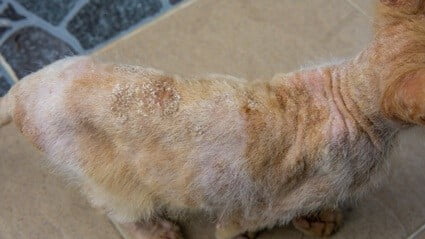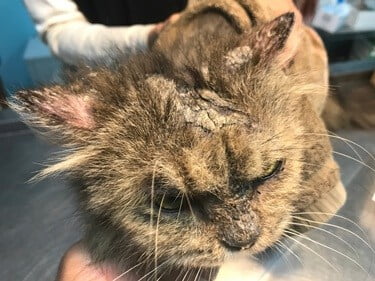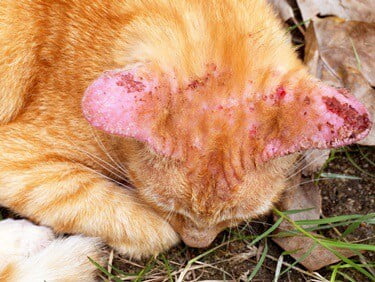Ringworm is a fungal infection that affects the deep layers of the skin. The fungi that cause ringworm are dermatophytes, which feed on the keratin found in a cat’s fur. All cats can get ringworm, but long-haired cat breeds and senior cats are most likely to develop it.
Cats can recover from ringworm on their own in 3-5 months. To speed up the ringworm recovery process, use a vet-prescribed topical ointment or shampoo. Some vets prescribe oral anti-fungal medications to clear up dermatophytosis. Cats must be quarantined for 2-4 weeks during treatment.
You’ll know that your cat is recovering from ringworm when the rashes and bald patches begin to heal. If treated early, your cat should make a full recovery with no lasting skin damage or scarring.
What Is Ringworm?
Ringworm is a fungal infection caused by the fungus, dermatophyte.
This fungus relies on keratin to grow, enabling it to thrive near hair when infecting an organism. It’s most common in animals, but it can also be spread to humans.
According to the Journal of Feline Medicine and Surgery, a sub-species of dermatophytes, called Microsporum Canis, causes most ringworm infections in cats. Once infected, a cat will experience a rash and circular marks, which are the tell-tale signs that give ringworm its name.
What Does Ringworm Look Like On A Cat?
Whether on a cat or a human, ringworm looks the same. The only difference is a cat’s fur obscuring the actual marks and rashes caused on the skin.
Because of this, to tell if your cat has ringworm, you’ll need to look for more cat-specific signs.
These include the following:
- Hair loss, especially in small and ring-like patterns
- Over-grooming, with the cat itching or biting at its skin
- Red patches where the hair has fallen out (or when you push the hair aside to inspect closely)
- Skin rashes, with particularly rough, scaly skin
- Infected claws
- Short, course patches of hair where the follicles have broken down
Will Ringworm in Cats Resolve Itself?
Ringworm can go away on its own, but it may take 3-5 months.
During that time, your cat could spread the infection to humans or other pets in your home. Not to mention, a ringworm infection can be very uncomfortable for your cat.
Instead, use medication to treat ringworm and relieve your cat’s symptoms. When left untreated, ringworm can also cause miliary dermatitis. According to the Journal of the American Veterinary Medical Association, this issue is mostly related to allergens.
At the very least, a long-term case of ringworm will be uncomfortable. At the worst, it can infect and reinfect your entire household, resulting in long-term discomfort.
What Cures Ringworm in Cats?
For mild cases of ringworm infection, a vet will prescribe a topical ointment, an anti-fungal cream, or a medicated shampoo. You’ll have to apply these products to your cat’s affected skin directly to get rid of ringworm.
If topical medications don’t work, your vet will prescribe oral anti-fungal medications. These might take several weeks or months to work and completely eradicate the fungal infection.
The Microsporum Canis fungi can remain infectious for up to 1 ½ years, so you need to prevent recurrence during the ringworm recovery period.
Cat Ringworm Healing Stages
There are four stages to the cat ringworm healing process, which include:

Stage 1: Quarantining Your Cat
Confine your cat to one room to reduce the risk of infecting people and animals.
If you don’t have a spare room to confine your cat, keep it in a cat carrier. Designate a specific area of the house for your cat to eat and exercise. Avoid sending your cat outdoors to roam, as it can infect other animals.
Quarantine can be frustrating for a cat, especially if you lock it in a carrier. Provide stimulation, such as cat toys and trees, to ease the process.
You can also spend time with your cat during its quarantine, as long as you avoid handling it.
Stage 2: Treatment
Once the cat is contained to a safe area, the treatment stage begins. This can take three different forms or involve combining all of them.
Topical Cream or Ointment to the Skin
The most effective treatment for ringworm infection is a topical cream or ointment. These products need to be applied directly to the cat’s skin to kill off the dermatophytes and heal the skin.
While there are several branded options, the main ingredient will be miconazole. It works to soothe the discomfort caused by ringworm while also removing the fungal infection.
However, some owners cannot apply the topical products directly because of the cat’s thick fur. In this case, your vet may suggest that you shave certain areas. Otherwise, thick fur can block the medication, rendering it ineffective.
Prescription Shampoo
In addition to topical medications, your vet may prescribe a medicated shampoo designed to treat ringworm. If your cat is a long-haired breed or has a severe ringworm infection, they may suggest shampoo instead of topical ointments.
The main purpose of a medicated shampoo is to treat a cat’s entire body. Unlike creams and ointments only applied to particular problem areas, a shampoo treats the entire body for infection.
Whether vet-prescribed or bought over the counter, a quality brand will have three components:
- Soothing Additives: Aloe vera is a common ingredient that soothes and treats the cat’s skin from the damage caused by ringworm.
- Chlorhexidine: This has anti-bacterial properties and will target any associated infections that develop alongside ringworm.
- Ketoconazole: This is an anti-fungal ingredient that targets ringworm in all its stages, as well as reducing any itching.
You need to shampoo your cat at least twice a week for the treatment to work. Apply the product liberally on your cat’s fur and skin, and let it sink in for 10 minutes before washing it off.
Wear gloves while shampooing your infected cat. You should also be careful when drying your cat, as rough and harsh movements can knock off scabs and cause bleeding.
Oral Medication
Some vets prescribe oral, anti-fungal medications in addition to topical treatments and medicated shampoos. That’s likely if the infection has progressed beyond the mild stage.
The most common drugs prescribed for ringworm infections include:
- Griseofulvin
- Terbinafine
- Ketoconazole
- Itraconazole
Your vet will prescribe an oral medication dose for around 6 weeks.
Stage 3: Exfoliate to Promote Healing
Ringworm can leave unsightly marks on your cat’s skin that can resolve themselves with time. To aid the healing process, you can exfoliate your cat’s skin.
Exfoliating kits are available at local pet stores, but choose one that’s designed especially to suit a cat’s skin and its pH level.
Stage 4: Clean Your House
If your cat has been diagnosed with ringworm or just recovered from it, it can be reinfected. To minimize the risk of reinfection, you must clean the house thoroughly:
- Spray all surfaces and objects with an anti-fungal solution.
- Wash your cat’s bedding, including pillows and cushions, on high heat.
- Wash your cat’s litter tray and food bowls with a disinfectant.
- Throw away and replace toys that your cat played with while infected.
- Apply disinfectants to wooden or linoleum floor surfaces.
- Shampoo and vacuum the carpets in your home to kill stubborn dermatophytes that fall from the cat’s skin throughout the healing process.
- Launder clothing that your cat might have come in contact with.
- Wash the soft furnishings in your home like couches, cushions, drapes, and curtains.

Signs Ringworm Is Clearing
It can take anywhere between 2-4 weeks after treatment for you to see any improvement in your cat’s health and signs of ringworm going away.
You can tell that your cat has recovered when the skin clears up. Any marks should leave, and you’ll notice the re-growth of your cat’s hair.
If you’re dealing with a severe case, you may need to take your cat back to the vet every 2 weeks so a culture sample can be taken.
You’ll know the ringworm is completely gone when two culture samples both come back clear.
How Long Does Cat Ringworm Take to Heal?
Without treatment, it can take anywhere between 3-5 months for a cat to heal itself.
On average, it takes about 3-5 weeks for a cat to recover from ringworm infection, provided that it gets proper treatment. The sooner you treat your cat, the sooner it’ll recover.
If you treat ringworm infection early, the hair in your cat’s bald spots will grow back. However, if you don’t treat it, the bald spots can be permanent.
How Long Is Ringworm Contagious in Cats?
Ringworm is a zoonotic disease and can be passed from an infected cat to a human or a pet that comes in contact with it. The condition can pose a risk to people and animals.
If your cat has ringworm, you need to quarantine it for at least 2-4 weeks to prevent the infection from spreading around your house.
Most healthy cats can heal without treatment within 3-5 months, but proper care and medication will enable them to recover faster.

